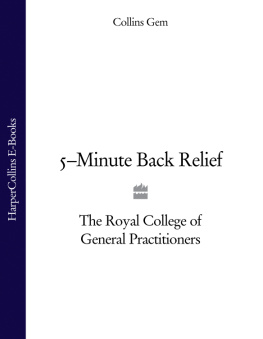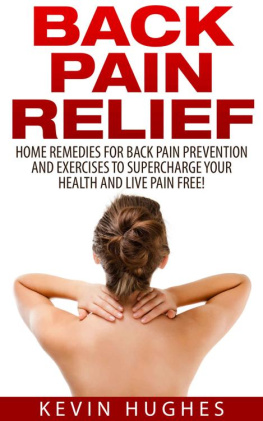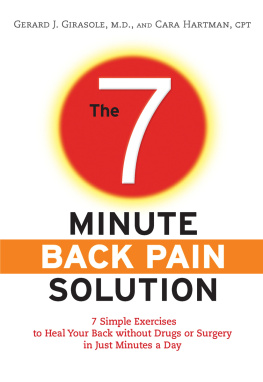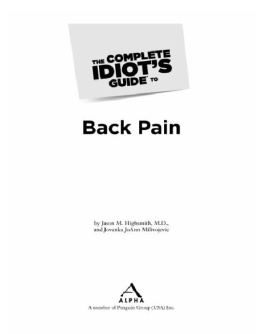Back pain, especially pain in the lower back, is one of the most common health problems in adults around the world. Fortunately most back pain is temporary, resulting from short-term stress on the muscles or ligaments that support the spine, rather than from a serious injury or medical condition such as nerve damage or kidney disease. But whatever the cause, and however short term the symptoms may be, the pain can be debilitating and, in the UK, results in over 11 million days off work every year and some 7 million visits to the doctor. Employers lose up to 335 million every year, and the cost to the health and community care services is over 1 billion.
According to the most recent statistics supplied by the UK Health and Safety Executive, back pain affects as many as four out of five of us. Other research shows that almost half of the adult population in the UK reports lower back pain lasting for at least 24 hours at some time during the year. In almost 80 per cent of cases, the problems recur, impacting on the lives of millions of sufferers.
The good news is that there is plenty that you can do to prevent back pain from becoming a chronic problem, to ease the symptoms and to make a successful recovery all by investing just a little time every day. Even those of you who have never been affected by back pain, but wish to improve the health of your back to prevent future problems, will benefit from the information and advice in this pocket-sized book.
Some of the exercises and programmes in this book may take a little time to learn and you may need a little help from a practitioner or expert to get you started but once youve mastered the basics, you can expect to make real progress in only five minutes a day.
Some of the advice and exercises will work as a short-term fix for acute pain; others will improve your back pain over time while making a big difference to your mobility, well-being, energy levels and the way you feel every day. There are a wealth of treatment options and restorative programmes in this book and you can pick and choose between them, according to your individual needs. Take time, too, to learn the secrets of a healthy back and how to prevent back pain from recurring in future.
Whether this is your first port of call before visiting your doctor, or you plan to use it alongside treatment, its never too early to get started. And with this book, youll be on the road to recovery in just five minutes a day.
Understanding how your back works and what can go wrong can make a big difference to the way you treat and use your back, and to how you view your symptoms. A little knowledge gives you the power to make changes that will in many cases relieve pain instantly, and in others help you to make progress towards a pain-free life.
The back is a complicated structure and many things can go wrong; some are more serious than others, and we will look at those here. However, even minor injuries or problems can cause excruciating pain in sufferers; it pays to know what to expect and how to get the appropriate treatment, whether you choose conventional or more alternative methods.
Well look at how to get your back problem diagnosed, and what to expect from the variety of different treatments now available. Most importantly, perhaps, well look at prevention, because taking steps to keep your back strong and healthy can not only prevent short-term back pain, but also ensure that problems do not recur in the future.
THE HEALTHY BACK
The back is an intricate structure of bones, ligaments, muscles, nerves and tendons. The backbone, or spine, is made up of 33 bony segments called vertebrae (see figure on p. 9). The vertebrae are arranged in a long vertical column and held together by ligaments, and are attached to muscles by tendons. Between each vertebra lies a gel-like cushion called an intervertebral disc, consisting of semifluid matter surrounded by a capsule of elastic fibres. Between the vertebrae are joints, called facet joints.
The discs absorb shock from the changing weight loads applied to the spine from excessive as well as normal activities such as walking, running, lifting and so on. The spines four natural curves also help to distribute these loads evenly, while providing structural support and stability. Facet joints and the discs allow the spine to bend and twist. Different muscles coordinate movement in many directions.
The spinal cord is an extension of the brain that runs through a long, hollow canal in the column of vertebrae. The meninges (the three membranes that cover the brain and spinal cord), cerebrospinal fluid (the fluid that bathes the brain and spinal cord), fat and a network of veins and arteries surround, nourish and protect the spinal cord.
Thirty-one pairs of nerve roots emerge from the spinal cord through spaces in each vertebra. These form the peripheral nervous system, or PNS, which is effectively the part of the nervous system outside the brain and spinal cord. The central nervous system (CNS) is comprised of the brain and spinal cord itself.
The PNS conveys sensory information from the body to the brain and instructions for the body to move, from the brain. In a healthy back, the nerves emerge easily and are not trapped or restricted by muscles, the vertebrae or the discs, and therefore do their job without any pain or discomfort. A healthy back is both flexible to provide movement and motion and stable to provide balance.
A healthy back is a balanced back: your cervical (neck), thoracic (chest) and lumbar (lower back) curves are all properly aligned. (You know your back is aligned properly when your ears, shoulders and hips are stacked in a straight line.) A healthy back is also protected and supported by its flexible, elastic discs and well-conditioned muscles.
Once you understand how your back works, and what can go wrong, youre ready to start taking care of your self. By using proper posture (when you sit, stand, lift, recline and move) and by exercising the muscles that support your back, you can prevent the most common causes of backaches. The result is freedom from back pain and a stronger, healthier back.
WHAT GOES WRONG
As we age, our spines change and the normal degenerative processes can affect the vertebrae, facet joints and discs. Trauma (such as injury), wear and tear, disease, lack of exercise and poor body mechanics (posture, lifting, bending, etc.) can alter the structural integrity of the spine, causing pain, discomfort and damage.
Pain is a symptom rather than an illness, so the important thing that you and your doctor will need to work out is what is causing the pain, and also what caused the problem in the first place. Pain can be referred from other sites in the body, including organs. For example, appendicitis, kidney disorders, pelvic or bladder infections, period pains, ovarian disorders and even aneurysms can cause pain to be referred to the back.
Common causes
Most back pain is not serious and usually resolves within a few weeks without treatment. Common non-specific back pain can develop in association with a number of causes, including muscle strain, minor injury to the back, overuse, muscle disorders, pressure on a nerve root and poor posture. Pregnant women, smokers (see p. 33), construction workers and people who do repetitive lifting all have increased risk of back pain.
When to see your doctor
If you are a regular back-pain sufferer, you may well be used to the symptoms, and have painkillers or a series of exercises or techniques to relieve the discomfort. This book is a good choice for you because, not only are there a variety of methods to deal with back pain, but also many ways to improve the health of your back. Unfortunately, as most of us learn, age does cause degeneration, and things give, rupture and strain more easily; in fact, studies show that over the age of 30, things take a turn for the worst and back pain is just one result of the normal degenerative process. So, while some back pain can be expected, and while there are many things you can do to combat this on your own, there are also times when you must see your doctor.






